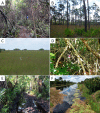Emergence potential of mosquito-borne arboviruses from the Florida Everglades
- PMID: 34807932
- PMCID: PMC8608345
- DOI: 10.1371/journal.pone.0259419
Emergence potential of mosquito-borne arboviruses from the Florida Everglades
Abstract
The Greater Everglades Region of South Florida is one of the largest natural wetlands and the only subtropical ecosystem found in the continental United States. Mosquitoes are seasonally abundant in the Everglades where several potentially pathogenic mosquito-borne arboviruses are maintained in natural transmission cycles involving vector-competent mosquitoes and reservoir-competent vertebrate hosts. The fragile nature of this ecosystem is vulnerable to many sources of environmental change, including a wetlands restoration project, climate change, invasive species and residential development. In this study, we obtained baseline data on the distribution and abundance of both mosquitos and arboviruses occurring in the southern Everglades region during the summer months of 2013, when water levels were high, and in 2014, when water levels were low. A total of 367,060 mosquitoes were collected with CO2-baited CDC light traps at 105 collection sites stratified among the major landscape features found in Everglades National Park, Big Cypress National Preserve, Fakahatchee State Park Preserve and Picayune State Forest, an area already undergoing restoration. A total of 2,010 pools of taxonomically identified mosquitoes were cultured for arbovirus isolation and identification. Seven vertebrate arboviruses were isolated: Everglades virus, Tensaw virus, Shark River virus, Gumbo Limbo virus, Mahogany Hammock virus, Keystone virus, and St. Louis encephalitis virus. Except for Tensaw virus, which was absent in 2013, the remaining viruses were found to be most prevalent in hardwood hammocks and in Fakahatchee, less prevalent in mangroves and pinelands, and absent in cypress and sawgrass. In contrast, in the summer of 2014 when water levels were lower, these arboviruses were far less prevalent and only found in hardwood hammocks, but Tensaw virus was present in cypress, sawgrass, pinelands, and a recently burned site. Major environmental changes are anticipated in the Everglades, many of which will result in increased water levels. How these might lead to the emergence of arboviruses potentially pathogenic to both humans and wildlife is discussed.
Conflict of interest statement
The authors have declared that no competing interests exist.
Figures








References
-
- Lodge TE. The everglades handbook, understanding the Everglades. Delray Beach, FL: St Lucy Press; 1994.
-
- National Park Service. National Park Service visitor use statistics [Sept 1, 2020]. Available from: https://irma.nps.gov/Stats/.
Publication types
MeSH terms
Grants and funding
LinkOut - more resources
Full Text Sources
Medical

